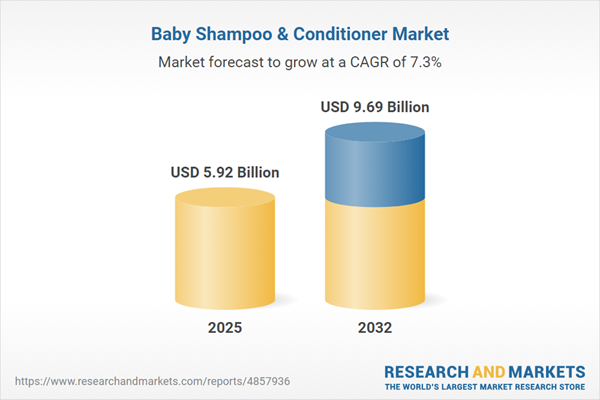Speak directly to the analyst to clarify any post sales queries you may have.
The baby shampoo and conditioner market is transforming as companies respond to evolving regulations, increased consumer scrutiny regarding ingredients, and demands for transparent supply chains. Senior decision-makers are prioritizing agility and compliance to maintain competitive positioning in this sector.
Market Snapshot: Global Baby Shampoo and Conditioner Market Overview
The global baby shampoo and conditioner market achieved a valuation of USD 5.52 billion in 2024, driven by a projected CAGR of 7.29% through 2032. Strong growth is underpinned by heightened consumer preference for safer products and full transparency on formulations. Market leadership now pivots on the ability to navigate compliance, pursue portfolio flexibility, and advance omnichannel engagement. Companies experiencing expansion in both mature and high-potential regions are leveraging regulatory harmonization and targeted campaigns to broaden market access. Investments in operational efficiency and tailored product development are also vital, as firms focus on enhancing brand loyalty within the baby personal care segment.
Scope & Segmentation of the Baby Shampoo and Conditioner Market
- Product Types: Single-use shampoos, exclusive conditioners, and versatile 2-in-1 formulas diversify offerings and support continual innovation for varying infant care needs.
- Form Formats: Foams, gels, and liquids satisfy a broad spectrum of caregiver preferences and foster adaptability in packaging and product delivery.
- Nature of Ingredients: Organic and conventional ingredient options fuel strategic product differentiation and address regulatory and sustainability expectations.
- Packaging Solutions: Traditional bottles, compact travel packs, and eco-friendly pouches improve user convenience and align with region-specific requirements.
- Distribution Channels: Supermarkets, pharmacies, specialist baby stores, and online platforms enable comprehensive and accessible delivery to both established and emerging markets.
- Regional Coverage: Americas, Europe, Asia-Pacific, Middle East, and Africa each add unique customer expectations and compliance needs, requiring campaign and product adaptation.
- Leading Companies: Key players such as Johnson & Johnson Services Inc., Unilever PLC, L’Oréal S.A., Himalaya Global Holdings Ltd., and Honasa Consumer Limited (Mamaearth) demonstrate sustained innovation and rigorous compliance focus.
Key Takeaways for Senior Decision-Makers
- Deploying digital analytics enhances product personalization, fostering stronger engagement and loyalty throughout customer interactions.
- Transparent supply chains anchored in responsible sourcing and eco-conscious packaging practices underpin lasting relationships with partners and consumers.
- Collaborating with certification bodies and medical experts bolsters market credibility and unlocks targeted growth in both established and high-potential regulatory landscapes.
- Multi-channel strategies, including direct-to-consumer programs and subscription offerings, mitigate risks amid evolving retail conditions.
- Localizing products and messaging builds relevance in quickly expanding or currently underserved customer segments within the baby personal care space.
- Continuous investment in advanced quality control and compliance technology supports rapid response to regulatory changes, securing multi-region market access.
Tariff Impact: Optimizing Supply Chain Resilience
Recent shifts in U.S. tariffs have increased operational costs across supply chains for baby shampoo and conditioner products. Firms are addressing these pressures by broadening supplier networks, implementing nearshoring initiatives, and strengthening procurement relationships. Incorporating digital trade management platforms and flexible logistics tools remains critical to maintaining regulatory compliance, limiting disruptions, and preserving smooth supply flows.
Methodology & Data Sources
This analysis is based on direct interviews with industry decision-makers and procurement experts, complemented by validated secondary research. Findings are subject to expert and regulatory review, ensuring alignment with the priorities of executives within the baby shampoo and conditioner market.
Why This Report Matters
- Equips businesses to design resilient entry and risk management strategies in response to shifting compliance and stakeholder demands.
- Facilitates operational and supply chain improvements in line with current advancements and evolving transparency expectations in ingredient sourcing.
- Delivers actionable insights for confident benchmarking and strategic decision-making to help stakeholders achieve measurable results.
Conclusion
Through dedicated innovation, digital optimization, and vigilant regulatory compliance, companies are equipped to secure sustained performance and sharpen their edge in the evolving baby shampoo and conditioner market.
Additional Product Information:
- Purchase of this report includes 1 year online access with quarterly updates.
- This report can be updated on request. Please contact our Customer Experience team using the Ask a Question widget on our website.
Table of Contents
3. Executive Summary
4. Market Overview
7. Cumulative Impact of Artificial Intelligence 2025
Companies Mentioned
The companies profiled in this Baby Shampoo & Conditioner market report include:- Johnson & Johnson Services Inc.
- Himalaya Global Holdings Ltd.
- Marico Limited
- Tedibar Ltd.
- Mamaearth by Honasa Consumer Limited
- Unilever PLC
- Amishi Consumers Technologies Pvt. Ltd.
- Mothercare by Reliance Brands Limited
- R for Rabit The Amazing Baby Company
- Baby Forest
- Tikitoro
- Emmbros Overseas Lifestyle Pvt Ltd.
- Tuco intelligent by The Unbottle Co.
- Bodycupid Private Limited
- L'oreal S.A.
Table Information
| Report Attribute | Details |
|---|---|
| No. of Pages | 197 |
| Published | October 2025 |
| Forecast Period | 2025 - 2032 |
| Estimated Market Value ( USD | $ 5.92 Billion |
| Forecasted Market Value ( USD | $ 9.69 Billion |
| Compound Annual Growth Rate | 7.2% |
| Regions Covered | Global |
| No. of Companies Mentioned | 16 |









